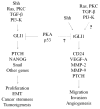Hedgehog pathway and GLI1 isoforms in human cancer
- PMID: 22369969
- PMCID: PMC3632644
Hedgehog pathway and GLI1 isoforms in human cancer
Abstract
The Hedgehog signaling pathway regulates normal cell growth and differentiation. When deregulated, the Hedgehog pathway leads to tumorigenesis and supports more aggressive phenotypes of human cancers, such as progression, metastasis, and therapeutic resistance. The glioma-associated oncogene homolog 1 (GLI1) family of zinc finger transcription factors is the nuclear mediator of the Hedgehog pathway that regulates genes essential for various stages of tumor development and progression. Consequently, several components of the Hedgehog pathway are major targets of cancer therapy, including GLI1 and smoothened. Although the GLI1 gene was initially identified as an amplified gene in glioblastoma, its amplification was found to be relatively rare. No somatic mutations have been reported in the GLI1 gene. Notably, two decades after the discovery of the GLI1 gene, the GLI1 transcript was recently found to undergo alternative splicing forming two shorter isoforms, an N-terminal deletion variant (GLI1ΔN) and a truncated GLI1 (tGLI1). These variants appear to have different patterns of tissue expression and functions. Most notably, the tGLI1 isoform behaves as a gain-of-function GLI1 that can induce expression of genes not regulated by GLI1 and promotes more aggressive cancer phenotypes. Therefore, this review will focus on the structural and functional differences between these isoforms, and also on their contributions to important cancer cell characteristics, including proliferation, motility, invasion, and angiogenesis.
Conflict of interest statement
The authors report no conflicts of interest.
Figures


Similar articles
-
Identification, functional characterization, and pathobiological significance of GLI1 isoforms in human cancers.Vitam Horm. 2012;88:115-40. doi: 10.1016/B978-0-12-394622-5.00006-7. Vitam Horm. 2012. PMID: 22391302 Free PMC article.
-
Hedgehog Signaling and Truncated GLI1 in Cancer.Cells. 2020 Sep 17;9(9):2114. doi: 10.3390/cells9092114. Cells. 2020. PMID: 32957513 Free PMC article. Review.
-
Novel human glioma-associated oncogene 1 (GLI1) splice variants reveal distinct mechanisms in the terminal transduction of the hedgehog signal.J Biol Chem. 2008 May 23;283(21):14345-54. doi: 10.1074/jbc.M800299200. Epub 2008 Mar 31. J Biol Chem. 2008. PMID: 18378682 Free PMC article.
-
Upregulation of VEGF-A and CD24 gene expression by the tGLI1 transcription factor contributes to the aggressive behavior of breast cancer cells.Oncogene. 2012 Jan 5;31(1):104-15. doi: 10.1038/onc.2011.219. Epub 2011 Jun 13. Oncogene. 2012. PMID: 21666711 Free PMC article.
-
Prognostic Role of Hedgehog-GLI1 Signaling Pathway in Aggressive and Metastatic Breast Cancers.Curr Drug Metab. 2020;21(1):33-43. doi: 10.2174/1389200221666200122120625. Curr Drug Metab. 2020. PMID: 31969097 Review.
Cited by
-
Role and inhibition of GLI1 protein in cancer.Lung Cancer (Auckl). 2018 Mar 27;9:35-43. doi: 10.2147/LCTT.S124483. eCollection 2018. Lung Cancer (Auckl). 2018. PMID: 29628779 Free PMC article. Review.
-
Sonidegib for the Treatment of Advanced Basal Cell Carcinoma.Front Oncol. 2020 Oct 30;10:582866. doi: 10.3389/fonc.2020.582866. eCollection 2020. Front Oncol. 2020. PMID: 33194718 Free PMC article. Review.
-
The Impact of Hedgehog Signaling Pathway on DNA Repair Mechanisms in Human Cancer.Cancers (Basel). 2015 Jul 21;7(3):1333-48. doi: 10.3390/cancers7030839. Cancers (Basel). 2015. PMID: 26197339 Free PMC article. Review.
-
GLI1: A Therapeutic Target for Cancer.Front Oncol. 2021 May 25;11:673154. doi: 10.3389/fonc.2021.673154. eCollection 2021. Front Oncol. 2021. PMID: 34113570 Free PMC article. Review.
-
Epithelioid Soft Tissue Neoplasm of the Soft Palate with a PTCH1-GLI1 Fusion: A Case Report and Review of the Literature.Head Neck Pathol. 2022 Jun;16(2):621-630. doi: 10.1007/s12105-021-01388-4. Epub 2021 Oct 16. Head Neck Pathol. 2022. PMID: 34655412 Free PMC article. Review.
References
-
- Arheden K, Ronne M, Mandahl N, Heim S, Kinzler KW, Vogelstein B, Mitelman F. In situ hybridization localizes the human putative oncogene GLI to chromosome subbands 12q13.3-14.1. Hum Genet. 1989;82(1):1–2. - PubMed
-
- Bergers G, Benjamin LE. Tumorigenesis and the angiogenic switch. Nat Rev Cancer. 2003;3(6):401–410. - PubMed
Publication types
MeSH terms
Substances
Grants and funding
LinkOut - more resources
Full Text Sources

